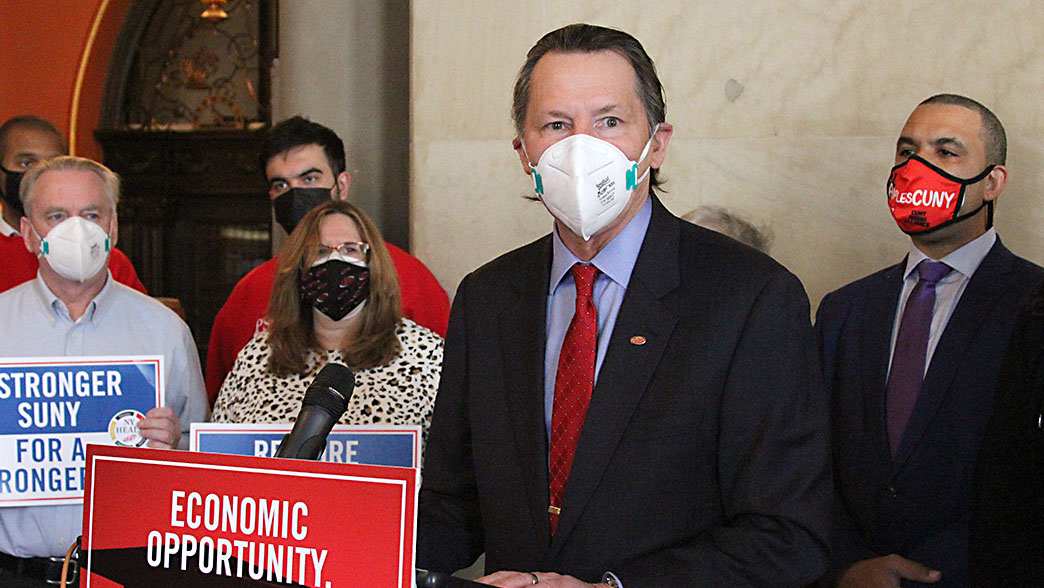
UUP joined with the Professional Staff Congress/CUNY Feb. 7 for a day of advocacy in which the leaders of both unions told lawmakers that although Gov. Hochul’s higher education budget is a help, it still falls short of the dire needs of both systems.
UUP President Fred Kowal and PSC President James Davis, along with an impressive gathering of lawmakers and other advocates of public higher education, made an impassioned case for a stronger higher education budget during a morning press conference in the Capitol. That afternoon, the two presidents testified before a joint hearing by the state Senate and Assembly higher education committees.
Both unions have asked the state to increase funding to SUNY and CUNY by more than $250 million for each system.
A CALL TO END AUSTERITY
“We want to make this the year where we turn the page on austerity once and for all, and make SUNY the leader that that New Yorkers need,” Kowal said during the press conference. He was flanked by Carolyn Kube, UUP’s statewide vice president for professionals; Tom Hoey, the statewide membership development officer; nine members of the Senate and Assembly; and several other advocates of public higher education, including Blair Horner, executive director of the New York State Public Interest Research Group.
Kowal noted that state funding to SUNY is down $7.35 billion since the start of the Great Recession in 2008. The state eliminated its $87 million in operating aid to the three SUNY hospitals five years ago, and the hospitals have lost millions more in revenue during the two years of the coronavirus pandemic, because elective medical procedures have either been stopped or severely reduced for much of the last two years.
“What that means is that our students and patients have lost millions each year,” Kowal said. “The hospitals and their employees have been pushed to the brink.”
Gov. Hochul’s executive budget proposes an increase of $118.7 million in state aid for operations and programs at SUNY. That at least halts a long pattern of severe underfunding, and it is, as Kowal told lawmakers during his testimony, “a step in the right direction.”
But this year’s state budget does not begin to address the staggering losses to SUNY from the 15 years of flat or reduced state budgets, and, as Kowal testified, “…worst of all, the Executive Budget remains silent on the SUNY teaching hospitals.”
“MIND-BLOWING” LOSSES TO HOSPITALS
SUNY Downstate University Hospital has lost more than $150 million in revenue from loss of elective procedures.
“The financial hardship that these hospitals face after 15 years of underfunding is mind-blowing,” Kowal told lawmakers. “We’re in a pandemic. The need is desperate. If not now, when?”
Lawmakers asked Kowal several questions about the hospitals, including whether it would help them if the state would agree to fund their debt service. The three teaching hospitals are the only SUNY institutions that pay their own debt service.
Kowal told them it would indeed help because the debt service equals about $87 million – which is also the amount the hospitals lost when the state eliminated their operating funds. UUP calls that money mission funding, a term the union considers more descriptive of the public service role of the hospitals.
“We need to get back to funding these institutions for what they are,” Kowal said during the discussion of the debt service. “They are public hospitals that are not getting public funding. The resources this year are available, and they need to be place where they are needed.”
